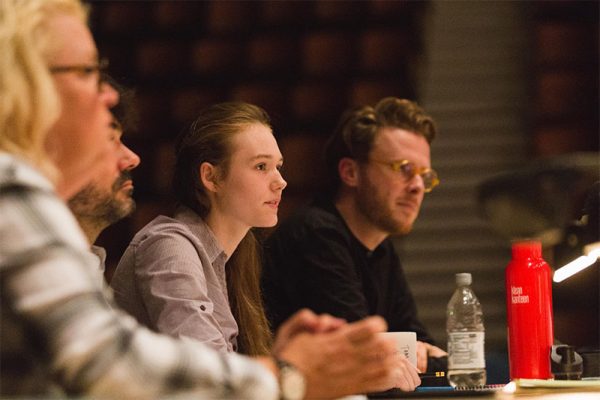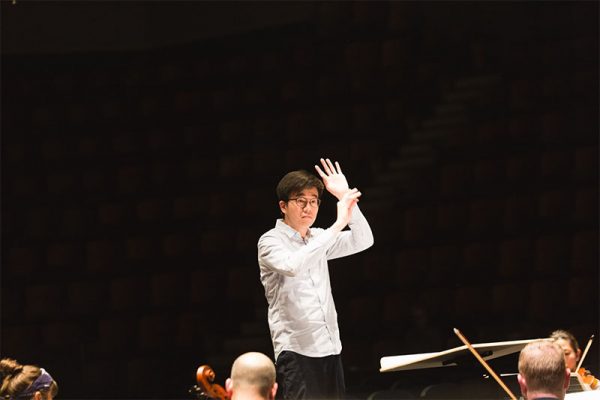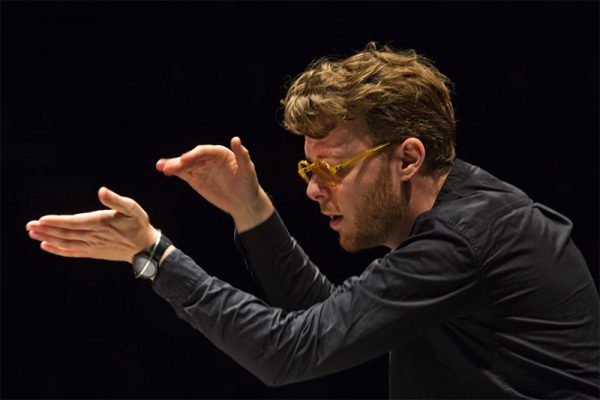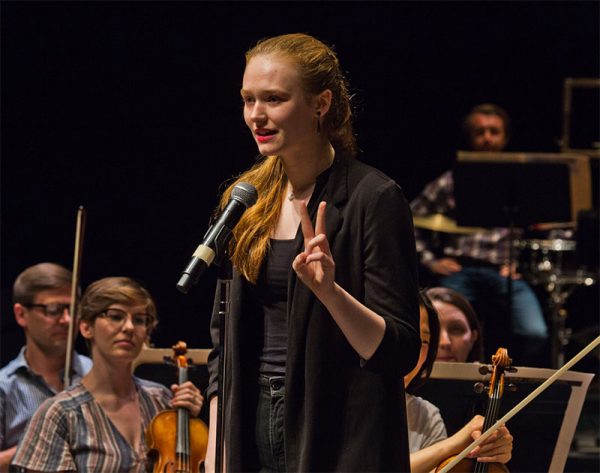
On Tuesday, July 30th, I had the pleasure of attending In the Works, a concert which showcased the new compositions of three emerging composers: Costas Dafnis, Maya Miro Johnson, and Annika Socolofksy. Each work was performed twice with a different conductor. This gave concert-goers the opportunity to experience the variations that result from a conductor’s interpretation. In the repeated performances of the pieces, I noticed different compositional elements and musical/sonic qualities—and while on the one hand, this was a natural result of hearing the works multiple times, it was also clear that my listening experience was influenced by the conductors’ choices. While I was fascinated by all of the works that came out of the Conductors/Composers Workshop, the piece that I was itching to learn more about after hearing it performed several times, was Maya’s change is the only constant (conducted by Alvin Ho and Toby Thatcher), a work about expansion and contraction, the Fibonacci sequence and its occurrences in nature, and three different types of change (personal, sociopolitical, and mathematical/environmental). I was intrigued by these ideas, by the unique instruments the piece utilized (such as a slinky and a sound hose, also known as a whirly tube), and by the way that the piece felt both chaotic and highly contained within a structure. I could feel the pulse throughout, I was guided from one sound to the next, I was aware of the conversations and tensions between sounds, and I could physically experience the described expansions and contractions throughout the piece.
It was a great treat, then, to sit down with Maya and get an idea of where her work sprung from, as well as how the concepts she explained before the performance of her work manifested within the composition. On the topic of her initial composition process Maya shared, “With this piece, I had a musical idea that was about the passage of time. I needed to have an orchestra piece of seven minutes or less.” Maya then explained how she initially envisioned creating the sonic expression of expansion and contraction in relation to time, and how this led to her final concept of (as she put it during the concert) “becoming rather than being”:
“Let’s just say the trumpet has one sound, and you hear that sound at zero minutes. And then the next time you hear the sound, it happens two minutes later, and then one minute later, and then thirty seconds later, and then fifteen second later, and then let’s say you get up to one second and it starts to reverse itself—[occurring at] fifteen seconds, thirty seconds, one minute, two minutes… That just turned out to be kind of banal because it didn’t give me too much material to work with. It’s also very esoteric because I don’t know if you can actually hear it. But it was something I started thinking about. Then I started thinking about time, and change from a musical perspective, and then suddenly the sonic stuff started to link with a rhetorical message.”

That rhetorical message was change and the three different categories through which she considered it. Her concept of personal change way driven by the question, “Am I the same person I was ten years ago, or are we two individuals?” When Maya shared with the audience that her piece was also largely inspired by the changes that have occurred within the sociopolitical climate, there was an audible response of understanding. However, she chose to leave the concept of sociopolitical change more open-ended than the concept of personal change, so as to not alienate anyone. Her piece does not “slant one way or the other,” but is interested in “how change has always existed, how it’s being emphasized now, and how people are becoming more aware of it.” Maya’s piece, encompassing an interest in both private and public change, fits perfectly into the 2019 Festival season, which includes many other works that address varying experiences of change. In the more personal category, Jake Heggie’s The Work at Hand deals with the feelings and processes of grief as depicted by the poetry of the late Laura Morefield. Kristin Kuster’s When There are Nine, is about Justice Ruth Bader Ginsburg and the sociopolitical changes she effected. Maya’s work balances the personal and the public experience of change through its literal use of changes in timing. Maya explained, “I was actually thinking about nature and mathematics and the Fibonacci sequence. I know that’s kind of a tired cliché in music—people love the Fibonacci—but it’s actually really beautiful. A lot of the gestures you hear rhythmically are spaced apart [in a sequence of] 1 1 2 3 5 8 13, whether it’s pitches, rhythms, silences, etc. And then I knew that the percussion was going to be a central focus.” I wasn’t surprised to hear that Maya’s composition was informed by such rhythmic intention—Maya is also a tapper, and in 2018 composed all that is solid (a study in entropy), a piece for tap dancer and chamber ensemble. In the program notes for this work, she writes, “I have always been fascinated by the interaction of motion and sound. In the art forms of both music and tap dance, music and movement are not in opposition but in coevolution.” Maya’s Festival work was certainly full of motion, both in terms of the sense of movement created by the interacting sounds and in terms of how the musicians moved their bodies.

Many of the sounds the composition calls for require noteworthy gestures from the orchestra. The sound hose, for example, demands a continuous whirling with the percussionist’s right hand. If they whirl the hose faster, the pitch rises, though Maya clarified that with any individual sound hose, there is a baseline pitch that acts as the fundamental. When I asked her about how she notates that sound, she shared, “When you’re approaching an instrument that’s unusual, you have to imagine how the sound is made.” She also had to keep in mind just how tiring it is to perform the whirling gesture. Other striking gestures found within the piece include bouncing the bow on the string of the cellos and basses, as well as blowing into the brass instruments in such a way that produces toneless air sounds. To bring about some of these sounds, the conductors perform unique movements as well. I recall one moment in which conductor Toby Thatcher wiggled his fingers so as to initiate a high and wavering pitch that I believe was produced by the slinky. It was actually his gesture that drew my attention to the sound. In response to my questions about how she goes about notating these sonic moments, Maya explained:
“I have a lot of notation in my piece (and in my work in general) that are things that I kind of made up because I couldn’t find a good alternative. There are alternatives, I just have not found them yet. I didn’t invent anything, but I did “brand it” to a certain extent. For example, the way that I notate an air sound in the brass is going to be very different than the way someone else notates it, but as long as it’s clear what it is to the ensemble, and it’s consistent that throughout the piece you use the same visual indication to communicate that sound, then they’ll figure it out.”
In describing her notation system, Maya emphasized that “there’s nothing new under the sun.” She is keen on the idea of reinvention and reconceptualization as a way of arriving at the “new,” taking a large amount of inspiration from artists such as Jennifer Walshe and Johannes Kreidler, whose genre of work she described as “music with a hugely expanded vocabulary, using visual art and motion—theater, essentially—to communicate musical ideas and concepts.”
I am fascinated by Maya’s wide influence of dance, philosophy, performance art, and poetry in addition to classical and contemporary music. Reading her program notes and listening to her describe her work, it’s clear that she appreciates language as an expressive tool. She has an extensive poetry portfolio that you can find on her website, and even her composition list includes descriptions that read like theatrical scores, one example being her interdisciplinary work, Sun Damage, which notes, “1 performer and wine glass, notebook, pencil, water, hat, sunscreen, and optional hairdryer.” Curious to know more about the intersections of these different expressive modalities, as well as the ideas that drive her work, I asked her to break down the terms “gestalt” and “gesture” which are key to her compositions. She explained,
“Gestalt is a German word, and very loosely translated, means shape, or form—not a traditionally dogmatic, ‘This is an ABA ternary form or sonata form,’ but rather, ‘What does it look like?’ For example, when you’re looking at a sculpture, there are lots of details to take in, but when you squint your eyes, you can see the overall blurry shape of the thing—how much space it takes up. So that’s kind of the idea of gestalt, an overarching emphasis on one idea and the shape of the piece. So, I think that [change is the only constant] is actually pretty successful at that, because every single idea in the piece, every sound you hear, is lending itself to the overall concept, or the gestalt, or the change.”

Maya’s description of gesture is largely tied to gestalt, also revolving around the formation of a shape. She invoked several metaphors to help me understand gesture in the musical sense of the term—one being that of a child’s room full of multiple Lego structures:
“You know when you’re playing with Legos, there’s one block and then two blocks and then three blocks, and eventually there are 400 blocks, but they’ve made a shape. So, those blocks are types of sound (like a rhythm, or a melody, or a pitch). Then, as a composer, you relate those Legos to each other and make an overall shape [. . .] One piece could have one gesture or one-piece could have 50,000 gestures, it’s just a matter of how you structure them together.”
When I replied that her piece felt like one large gesture made up of many small movements, she compared this phenomenon to a Matryoshka doll, pointing out that just as the wooden dolls are whittled down to fit perfectly inside each other, the smaller gestures of a composition must be carefully crafted to fit inside the larger gestures. For Maya, this whittling process is linked to the act of inserting meaning into a piece:
“It’s really hard to get the dolls to fit inside each other and that’s the real challenge of composition, I think. It’s not coming up with material, because everyone comes up with material. You write emails every day. That’s coming up with material [. . .] People are very creative. People can look at a blank page and fill it. They have a compulsion to fill a blank page, but it’s putting the meaning into the blank page [that’s challenging]. That’s what makes a real artist… is someone who can craft and do so in a way that’s conscious of precedent, conscious of historical events, and conscious of how your music is going to fit into the picture 300 years from now, whether or not people are even going to remember it.”

Composing is, for Maya, a way of communicating her ideas and, with the help of the conductor and orchestra, opening up a conversation: “For me, it’s like composing an essay that’s also a poem and that’s also an invitation for the audience to think about something deeper.” She recognizes that people may not always like what they hear and that some pieces will be better than others, but, she says, “it’s your goal to always try to be consistent and forward-looking for yourself.”
While creating meaningful work is very important to Maya, she also shared that sometimes, she’s more interested in experimentation:
“like right now I’m having a bassoon trio [. . .] workshopped. They’re just sending me sound bites and then I’m texting them back and being like ‘Ooo can you try this, or maybe at letter L try this material instead, or add a bar here, or maybe cut all this and send me all the different versions you come up with for this sound’…it’s like a laboratory. And so that’s the type of play that I will do.”
Maya also takes time to study and play other people’s work (on the violin) when she’s not composing herself. While exploring her many artistic and scholastic interests is quite playful and enjoyable, she explains,
“it’s a very serious thing for me. It’s like…you have a responsibility because you also have this incredible gift that someone has given you to be able to have a pulpit, essentially, and be able to send emotions and thoughts out into the world, and you had better take really good care of it. Be very careful what you say, say musically I mean, because people will run with it.”

Maya is very aware of what ideas she is putting out into the world, and how those ideas fit in with others that have been communicated in specific musical and cultural contexts. This awareness serves to help her form her artistic identity:
“I just think you should be yourself. Be the best version of yourself, and then, be relevant. Don’t just write music to write music, because lots of people can do that. Write music that really has something to say, and hopefully has something new to say. I mean, again, there’s nothing new under the sun, but the goal is to express something that only you can express, and then invite people to enjoy that.”
Enjoyment was easily read across the audience during the performance of change is the only constant. Maya’s experimentation was embedded in the work—her curiosity about shape, movement, sound, and rhythm, totally tangible and accessible. The piece seemed to me to ask for an openness to change, to qualitative shifts, to a teasing of expectations, and to nonlinear development. I’m so looking forward to seeing what she concocts next (and am secretly hoping she incorporates some of her poetry!).
For more on Maya, check out https://mayamirojohnson.com/.
*all photography by r.r.jones
